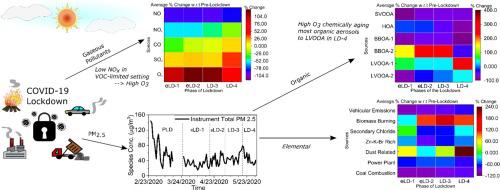Environment International ( IF 10.3 ) Pub Date : 2021-04-09 , DOI: 10.1016/j.envint.2021.106541 Chirag Manchanda , Mayank Kumar , Vikram Singh , Mohd Faisal , Naba Hazarika , Ashutosh Shukla , Vipul Lalchandani , Vikas Goel , Navaneeth Thamban , Dilip Ganguly , Sachchida Nand Tripathi

|
The Government of India (GOI) announced a nationwide lockdown starting 25th March 2020 to contain the spread of COVID-19, leading to an unprecedented decline in anthropogenic activities and, in turn, improvements in ambient air quality. This is the first study to focus on highly time-resolved chemical speciation and source apportionment of PM2.5 to assess the impact of the lockdown and subsequent relaxations on the sources of ambient PM2.5 in Delhi, India. The elemental, organic, and black carbon fractions of PM2.5 were measured at the IIT Delhi campus from February 2020 to May 2020. We report source apportionment results using positive matrix factorization (PMF) of organic and elemental fractions of PM2.5 during the different phases of the lockdown. The resolved sources such as vehicular emissions, domestic coal combustion, and semi-volatile oxygenated organic aerosol (SVOOA) were found to decrease by 96%, 95%, and 86%, respectively, during lockdown phase-1 as compared to pre-lockdown. An unforeseen rise in O3 concentrations with declining NOx levels was observed, similar to other parts of the globe, leading to the low-volatility oxygenated organic aerosols (LVOOA) increasing to almost double the pre-lockdown concentrations during the last phase of the lockdown. The effect of the lockdown was found to be less pronounced on other resolved sources like secondary chloride, power plants, dust-related, hydrocarbon-like organic aerosols (HOA), and biomass burning related emissions, which were also swayed by the changing meteorological conditions during the four lockdown phases. The results presented in this study provide a basis for future emission control strategies, quantifying the extent to which constraining certain anthropogenic activities can ameliorate the ambient air. These results have direct relevance to not only Delhi but the entire Indo-Gangetic plain (IGP), citing similar geographical and meteorological conditions common to the region along with overlapping regional emission sources.
Summary of main findings
We identify sources like vehicular emissions, domestic coal combustion, and semi-volatile oxygenated organic aerosol (SVOOA) to be severely impacted by the lockdown, whereas ozone levels and, in turn, low-volatility oxygenated organic aerosols (LVOOA) rise by more than 95% compared to the pre-lockdown concentrations during the last phase of the lockdown. However, other sources resolved in this study, like secondary chloride, power plants, dust-related, hydrocarbon-like organic aerosols (HOA), and biomass burning related emissions, were mainly driven by the changes in the meteorological conditions rather than the lockdown.
中文翻译:

德里COVID-19锁定期间化学成分和PM 2.5来源的变化
印度政府(GOI)宣布从2020年3月25日开始在全国范围内实施封锁,以遏制COVID-19的扩散,从而导致人为活动的空前减少,进而改善环境空气质量。这是第一项关注时间高度分辨的化学物形态和PM 2.5来源分配的研究,旨在评估印度德里的锁定和随后放宽对环境PM 2.5来源的影响。从2020年2月至2020年5月在IIT德里校区测量了PM 2.5的元素,有机和黑碳部分。我们使用PM 2.5的有机和元素部分的正矩阵分解(PMF)报告了源分配结果。在锁定的不同阶段。与锁定前相比,在锁定第1阶段,已解决的排放源,如车辆排放,家用燃煤和半挥发性氧化有机气溶胶(SVOOA),分别减少了96%,95%和86%。 。O 3浓度出现不可预见的上升,而NO x下降观察到的水平与全球其他地区相似,导致低挥发性的氧化有机气溶胶(LVOOA)在锁定的最后一个阶段增加到锁定前浓度的几乎两倍。发现锁定的影响在其他解决的来源上不太明显,例如二次氯化物,发电厂,与尘埃有关的,类似烃的有机气溶胶(HOA)以及与生物质燃烧有关的排放,这些因素也受到不断变化的气象条件的影响在四个锁定阶段。这项研究中提出的结果为未来的排放控制策略提供了基础,该策略量化了限制某些人为活动可以改善环境空气的程度。这些结果不仅与德里息息相关,而且与整个印度恒河平原(IGP)都息息相关,
主要发现摘要
我们确定了诸如汽车排放,家用燃煤和半挥发性含氧有机气溶胶(SVOOA)之类的资源将受到锁定的严重影响,而臭氧水平以及低挥发性含氧有机气溶胶(LVOOA)的上升幅度则超过与锁定最后阶段的锁定前浓度相比,降低了95%。但是,本研究中解决的其他来源,例如二次氯化物,发电厂,与尘埃有关的,类似烃的有机气溶胶(HOA)以及与生物质燃烧有关的排放,主要是由气象条件的变化而不是由锁定引起的。











































 京公网安备 11010802027423号
京公网安备 11010802027423号